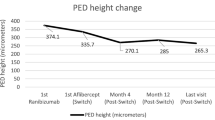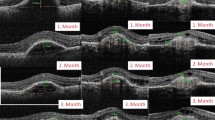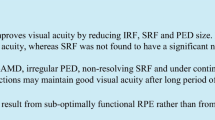Abstract
Purpose
To assess the anatomical and functional efficacy of ranibizumab on vascularized pigment epithelial detachment (V-PED) secondary to neovascular age-related macular degeneration (nAMD).
Methods
One hundred and nine patients (116 eyes) were retrospectively selected from medical records of 2097 patients who benefited from intravitreal injection between January 2011 and June 2013 in a tertiary-care University-based Department of Ophthalmology. Inclusion criteria were: nAMD, treatment-naive eyes, presence of V-PED higher than 250 μm, intravitreal ranibizumab with a loading phase, followed by a pro-re-nata regimen, and 1-year follow-up. Baseline characteristics and type of choroidal neovascularization (CNV) were analyzed. PED height, central macular thickness (CMT) and best-corrected visual acuity (BCVA, logMAR) were measured at baseline, months 3, 6 and 12.
Results
CNV was of type 1 in 91 eyes (78.4 %), type 2 in seven (6 %), type 3 in six (5.2 %), and polypoidal choroidal vasculopathy in 12 (10.3 %). Mean CMT at baseline was 572.1 μm and decreased to 396.6 μm (p < 0.0001) at 12 months. Mean height of PED was 458.2 μm at baseline and 306.8 μm (p < 0.0001) at 12 months. Mean BCVA improved from 0.46 at baseline to 0.39 at 12 months (p = 0.013).
Conclusions
Treatment with ranibizumab improved visual and anatomical outcome in nAMD patients with V-PED.


Similar content being viewed by others
References
Klein R, Klein BE, Knudtson MD, Meuer SM, Swift M, Gangnon RE (2007) Fifteen-year cumulative incidence of age-related macular degeneration. Ophthalmology 114(2):253–262
Querques G, Srour M, Massamba N et al (2013) Functional characterization and multimodal imaging of treatment-naïve “quiescent” choroidal neovascularization. Invest Opthalmol Vis Sci 54(10):6886–6892
Zayit-Soudry S, Moroz I, Loewenstein A (2007) Retinal pigment epithelial detachment. Surv Ophthalmol 52(3):227–243
Pepple K, Mruthyunjaya P (2011) Retinal pigment epithelial detachments in age-related macular degeneration: classification and therapeutic options. Semin Ophthalmol 26(3):198–208
Hartnett ME, Weiter JJ, Garsd A, Jalkh AE (1992) Classification of retinal pigment epithelial detachments associated with drusen. Graefes Arch Clin Exp Ophthalmol 230(1):11–19
Poliner LS, Olk RJ, Burgess D, Gordon ME (1986) Natural history of retinal pigment epithelial detachments in age-related macular degeneration. Ophthalmology 93(5):543–551
Brown DM, Kaiser PK, Michels M et al (2006) Ranibizumab versus verteporfin for neovascular age-related macular degeneration. N Engl J Med 355(14):1432–1444
Rosenfeld PJ, Brown DM, Heier JS et al (2006) Ranibizumab for neovascular age-related macular degeneration. N Engl J Med 355(14):1419–1431
Iordanous Y, Powell A, Mao A et al (2014) Intravitreal ranibizumab for the treatment of fibrovascular pigment epithelial detachment in age-related macular degeneration. Can J Ophthalmol 49(4):367–376
Suzuki M, Nagai N, Izumi-Nagai K et al (2014) Predictive factors for non-response to intravitreal ranibizumab treatment in age-related macular degeneration. Br J Ophthalmol 98(9):1186–1191
Ersoy L, Ristau T, Kirchhof B, Liakopoulos S (2014) Response to anti-VEGF therapy in patients with subretinal fluid and pigment epithelial detachment on spectral-domain optical coherence tomography. Graefes Arch Clin Exp Ophthalmol 252(6):889–897
Giansanti F, Bacherini D, Giacomelli G et al (2014) Intravitreal anti-VEGF therapy for vascularized pigment epithelium detachment in age-related macular degeneration. Eur J Ophthalmol 24(3):402–408
Panos GD, Gatzioufas Z, Petropoulos IK, Dardabounis D, Thumann G, Hafezi F (2013) Effect of ranibizumab on serous and vascular pigment epithelial detachments associated with exudative age-related macular degeneration. Drug Des Devel Ther 7:565–569
Ho AC, Busbee BG, Regillo CD et al (2014) Twenty-four-month efficacy and safety of 0.5 mg or 2.0 mg ranibizumab in patients with subfoveal neovascular age-related macular degeneration. Ophthalmology 121(11):2181–2192
Souied EH, Oubraham H, Mimoun G, Cohen SY, Quere S, Derveloy A (2015) Changes in visual acuity in patients with wet age-related macular degeneration treated with intravitreal ranibizumab in daily clinical practice: the TWIN study. Retina 35(9):1743–1749
Querques G, Azrya S, Martinelli D et al (2010) Ranibizumab for exudative age-related macular degeneration: 24-month outcomes from a single-centre institutional setting. Br J Ophthalmol 94(3):292–296
Lalwani GA, Lalwani GA, Rosenfeld PJ et al (2009) A variable-dosing regimen with intravitreal ranibizumab for neovascular age-related macular degeneration: year 2 of the PrONTO study. Am J Ophthalmol 148(1):43.e1–58.e1
Busbee BG, Ho AC et al (2013) Twelve-month efficacy and safety of 0.5 mg or 2.0 mg ranibizumab in patients with subfoveal neovascular age-related macular degeneration. Ophthalmology 120(5):1046–1056
CATT research group, Martin DF, Maquire MG, Ying GS et al (2011) Ranibizumab and bevacizumab for neovascular age-related macular degeneration. N Eng J Med 364(20):1897–1908
Gass JD (1984) Pathogenesis of tears of the retinal pigment epithelium. Br J Ophthalmol 68(8):513–519
Schmidt-Erfurth U, Eldem B, Guymer R et al (2011) Efficacy and safety of monthly versus quarterly ranibizumab treatment in neovascular age-related macular degeneration: the EXCITE study. Ophthalmology 118(5):831–839
Arora S, McKibbin M (2011) One-year outcome after intravitreal ranibizumab for large, serous pigment epithelial detachment secondary to age-related macular degeneration. Eye 25(8):1034–1038
Simader C, Ritter M, Bolz M et al (2014) Morphologic parameters relevant for visual outcome during anti-angiogenic therapy of neovascular age-related macular degeneration. Ophthalmology 121(6):1237–1245
Ying G, Huang J, Maguire MG et al (2013) Baseline predictors for one-year visual outcomes with ranibizumab or bevacizumab for neovascular age-related macular degeneration. Ophthalmology 120(1):122–129
Ying G, Kim BJ, Maguire MG et al (2014) Sustained visual acuity loss in the comparison of age-related macular degeneration treatments trials. JAMA Ophthalmol 132(8):915–921
Schmidt-Erfurth U, Waldstein SM, Deak G, Kundi M, Simader C (2015) Pigment epithelial detachment followed by retinal cystoid degeneration leads to vision loss in treatment of neovascular age-related macular degeneration. Ophthalmology 122(4):822–832
Inoue M, Arakawa A, Yamane S, Kadonosono K (2013) Variable response of vascularized pigment epithelial detachments to ranibizumab based on lesion subtypes, including polypoidal choroidal vasculopathy. Retina 33(5):990–997
Varshney N, Jain A, Chan V, Yu L, Sarraf D (2013) Anti-VEGF response in macular hemorrhage and incidence of retinal pigment epithelial tears. Can J Ophthalmol 48(3):210–215
Sarraf D, Chan C, Rahimy E, Abraham P (2013) Prospective evaluation of the incidence and risk factors for the development of RPE tears after high- and low-dose ranibizumab therapy. Retina 33(8):1551–1557
Chiang A, Chang LK, Yu F, Sarraf D (2008) Predictors of anti-VEGF-associated retinal pigment epithelial tear using FA and OCT analysis. Retina 28(9):1265–1269
Sarraf D, Reddy S, Chiang A, Yu F, Jain A (2010) A new grading system for retinal pigment epithelial tears. Retina 30(7):1039–1045
Sarraf D, Joseph A, Rahimy E (2014) Retinal pigment epithelial tears in the era of intravitreal pharmacotherapy: risk factors, pathogenesis, prognosis and treatment (an American Ophthalmological Society thesis). Trans Am Ophthalmol Soc 112:142–159
Cho HJ, Kim KM, Kim HS, Lee DW, Kim CG, Kim JW (2016) Response of pigment epithelial detachment to anti-vascular endothelial growth factor treatment in age-related macular degeneration. Am J Ophthalmol 166:112–119
Sakai T, Okano K, Kohno H, Tsuneoka H (2016) Three-year visual outcomes of intravitreal ranibizumab with or without photodynamic therapy for polypoidal choroidal vasculopathy. Acta Ophthalmol. doi:10.1111/aos.13130
Dirani A, Ambresin A, Marchionno L, Decugis D, Mantel I (2015) Factors influencing the treatment response of pigment epithelium detachment in age-related macular degeneration. Am J Ophthalmol 160(4):732–738
Author information
Authors and Affiliations
Corresponding author
Ethics declarations
Funding
No funding was received for this research.
Conflict of interest
All authors certify that they have no affiliations with or involvement in any organization or entity with any financial interest (such as honoraria; educational grants; participation in speakers’ bureaus; membership, employment, consultancies, stock ownership, or other equity interest; and expert testimony or patent-licensing arrangements), or non-financial interest (such as personal or professional relationships, affiliations, knowledge, or beliefs) in the subject matter or materials discussed in this manuscript.
Ethical approval
All procedures performed in studies involving human participants were in accordance with the ethical standards of the institutional and/or national research committee and with the 1964 Helsinki Declaration and its later amendments or comparable ethical standards. For this type of retrospective study, formal consent is not required.
Rights and permissions
About this article
Cite this article
Chevreaud, O., Oubraham, H., Cohen, S.Y. et al. Ranibizumab for vascularized pigment epithelial detachment: 1-year anatomic and functional results. Graefes Arch Clin Exp Ophthalmol 255, 743–751 (2017). https://doi.org/10.1007/s00417-016-3564-y
Received:
Revised:
Accepted:
Published:
Issue Date:
DOI: https://doi.org/10.1007/s00417-016-3564-y




